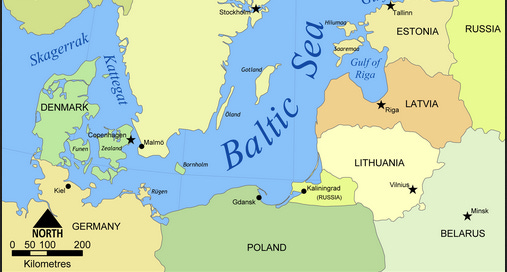Russia’s main threat to NATO is currently on the Baltic States front of Estonia south through Lithuania. Russian forces based in Russia and from Belarus could be the hammers that fall on the Kaliningrad anvil to isolate and conquer those three small NATO states by capturing the Suwalki Gap on the Poland-Lithuania border.
And as long as Ukraine remains independent and pro-Western, the Russian ground invasion threat to NATO will remain primarily limited to the Estonia-to-Poland front.
Sweden and Finland are new members of NATO that provide depth to the defense of the Baltic States and offer avenues to strike into Russia north of St. Petersburg as well as denying Russia use of the Baltic Sea.
The new strategy requires that we speak plainly about who our closest allies in Europe are going forward and focus on working closely with countries that share similar threat perceptions when it comes to Russia, are willing to decouple from China, and are spending money on defense to check Moscow’s neoimperial drive. These are countries that lie in the Northeast Corridor along NATO’s flank: Norway, Sweden, Finland, the Baltic States and Poland.
The Northeast Corridor is the new center of gravity of the NATO alliance, with Poland – much like West Germany of the Cold War era – now the critical hub of NATO’s European defense. These seven countries should be prioritized by the second Trump administration, including when it comes to our sales and co-production of advanced weapons systems. The administration should also consider shifting U.S. permanent bases out of Germany and into the region as well as investing in regional economic cooperation and infrastructure projects under the Three Seas Initiative umbrella endorsed and supported during the first Trump term.
The author doesn't include Germany in this grouping despite its importance for the Baltic front, but recognizes its importance:
Germany has an important role to play in NATO’s overall strategy and plans, for even though it’s no longer a frontier state, the size of its economy, its population and the geostrategic depth it provides remain vital to deterrence and defense across the Euro-Atlantic area.
I won't disagree with this view of the Baltic front. But I think it is already happening.
Poland is increasingly the new center of gravity for America's military.
And in part that centers on threats to the Baltic States. Russian aggression is pushing NATO to rebuild conventional war capabilities gone dormant after the collapse of the Soviet Union, which I note in this post that addresses NATO preparations for conventional war in the region. Which is possible as NATO finally addresses its eastern NATO logistics shortcomings.
Complicating Russian options, America is increasing exercises with Sweden and Finland who have recently joined NATO.
Indeed, I've worried that excessive NATO efforts in the Black Sea are a distraction from the main Baltic land front. In line with this concern, I think that NATO navies in the Mediterranean Sea can easily handle Russia's naval presence there. Even if Syria’s new rulers decide—notwithstanding Russia’s role in slaughtering Syrians to keep Assad in power—that they’d like Russia a counter-weight to other powers by letting Russian keep its bases in post-Assad Syria, the Russian flotilla would still lead a short but exciting life in a war with NATO.
As for Germany, because of the factors noted, Germany must be included. It has the demographic, scientific, and economic power to contribute to the Baltic front. And my view of the modern role of NATO enables Germany’s role in NATO plans for holding the Baltic front against the acute threat of Russia.
As Germany tentatively rearms, it should have a major role in securing the Baltic Sea. It already has a role in the logistics links from North America and Britain to the new front. It should have a role in capturing or suppressing Russia's Kaliningrad exclave.
The author also emphasized that Europeans must not undermine America's major focus on the pacing threat of China by bolstering China's economic and technological strength. That is a major argument for keeping America in NATO.
Despite American complaints about the cost of NATO, I think that you have to think of Europe as an objective and not only as an alliance. Holding Europe in friendly hands even if our friends don’t contribute as much as we’d like is important for our economic and defense strength. America has a long history of experiencing threats when we didn’t have Europe’s Atlantic coast in friendly hands.
Russia’s revived threats to Europe push Europeans back toward us and encourage increased defense spending, but the European Union remains a threat to that renewed unity of purpose. America should keep pushing those friends in Europe to do more and make sure NATO is not replaced by the EU in military operations.
Certainly the author's advice fits in well with my views on a robust American role with limited military assets in NATO to keep Europe our economy-of-force front. Walking away is self-defeating and more costly to America in the long run.
NOTE: Map pulled from https://upload.wikimedia.org/wikipedia/commons/1/19/Baltic_Sea_map2.png




